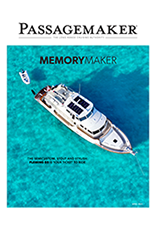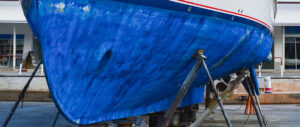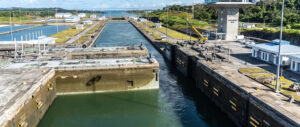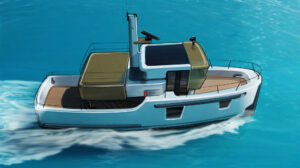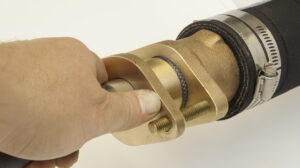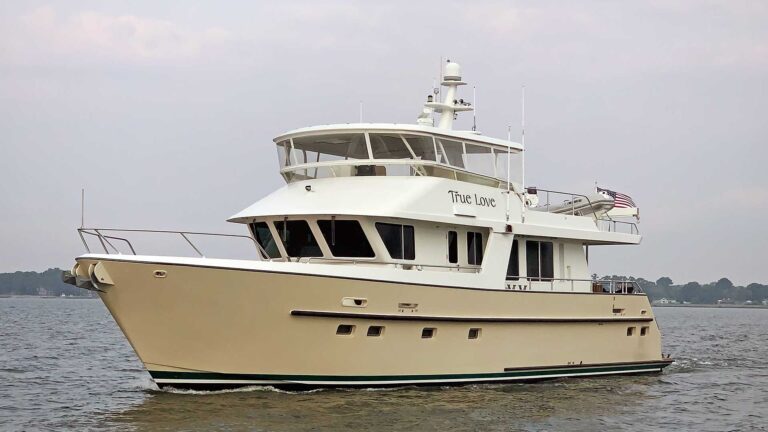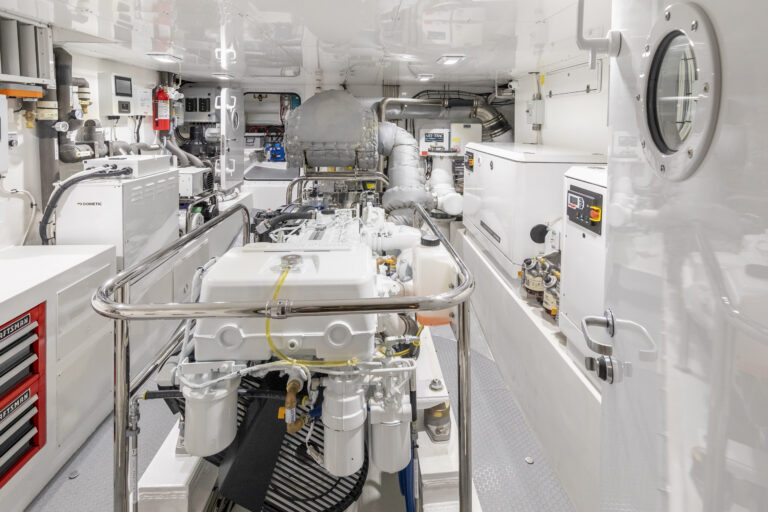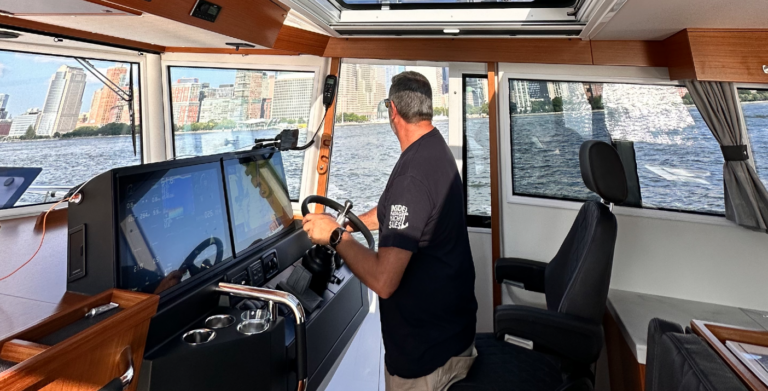Still waters may run deep, but deep waters are definitely not always still. The rolling motion of the ocean can make life aboard a seagoing vessel less than comfortable. Hence the thriving industry for companies trying to calm a rolling boat.
For the past 30 years, hydraulic active-fin stabilizers have been the choice of many builders of recreational trawlers and large motoryachts, and justifiably so, as they successfully work on most boats. In the late aughts, the recreational-yacht industry welcomed new players—including Seakeeper and Mitsubishi—into the market with advancement in gyrostabilizers. The gyros offered small- to medium-size boats effective stability, and came with the benefit of zero-speed stability, something active fins didn’t do particularly well.

Boatbuilders and owners are now welcoming another stabilizer technology, already successful in Europe and making inroads into North America. DMS Holland is manufacturing and marketing the DMS MagnusMaster, a rotary-tube stabilizer that uses the Magnus effect, a physical phenomenon named after German physicist Heinrich Gustav Magnus.
In simple terms, it is the same effect that allows a golfer to control the golf ball’s direction. A rotating object moving through the air or water creates a vortex around and behind it. This, in turn, creates a difference in pressure on opposite sides of the object. Pressure becomes lower on one side of the rotating object and greater on the other side. The pressure differential creates a dramatic amount of lift on the rotating object.

In the case of the golf ball, the spin allows the golfer to control the amount of loft and the direction of the ball’s travel. In the case of a boat, the spinning object is a rotor extending out from the side of the hull and coupled with a sensor in the boat. When the sensor perceives a rolling motion, the rotors spin in one direction or the other, producing pressures to counteract a boat’s rolling motion.
The Retrofit on Libra
Bill and Laurie Wavrin use their 52-foot Nordzee Kotter trawler Libra to cruise the scenic waters of the Pacific Northwest. Libra is a heavy-displacement, sturdily built boat with a gentle motion—at least to them. Their daughter and young grandchild found the boat’s rolling motion quite unsettling. So, Bill set out to find an easy-to-install way to reduce the boat’s roll.

Hydraulic active fins were the most logical choice, but he didn’t relish the thought of adding a complicated, expensive hydraulic system. A gyrostabilizer capable of handling a boat this heavy would have to be quite large and power-hungry, so that didn’t seem like a viable option either. Bill then came across the DMS MagnusMaster system. The all-electric system allowed for much easier installation, and the low power draw meant it could operate off an inverter and the existing battery system, without the need for a generator.
The only question was whether it would work. After thorough research, Bill realized this was not a new technology, but a proven concept already operating on hundreds of boats in Europe. It was just new to North America. So, he took the leap, and his family couldn’t be happier. In addition to preventing rolling, the system has a “forced roll” feature where he can use the rotors to induce a roll.
“They demonstrated the system by rolling 65 tons of boat 15 degrees on its ear in one second,” he says. “It was amazing. Something drawing so little power from the boat could exert so much force.”
Being based in Port Hadlock, Wash., Libra’s typical cruising grounds are across the Strait of Juan de Fuca, the Strait of Georgia or both. These waterways can see poor conditions throughout the year. Bill says the DMS installation has opened up more cruising opportunities for his family.

“Historically, we’ve had to pick our days,” he says. “The difference between a medium day and a flat day is now nothing. Rather than ‘should I go or not go,’ [it] becomes ‘of course I’m going to go because it’s not going to be the slightest bit uncomfortable,’ and before we probably would have waited it out.”
Partnerships with Builders
Retrofits like Libra’s are just one part of DMS Holland’s business. Another is convincing builders to install the system on new builds. One builder that has introduced the DMS Holland system to buyers is Netherlands-based Elling Yachts, which offers the MagnusMaster as an option to buyers.
On a recent trip to the Netherlands, I had the opportunity to go out on a 65-foot Elling E6 long-range motoryacht, outfitted not only with the MagnusMaster rotor system but also with a gyro. The owners, Bruce and Liz Jones, wanted stability across a range of speeds and conditions. They got it, all with the system running silently and efficiently off the boat’s house battery bank.
This demonstration showed me another big benefit too: The system’s ability to perform effectively at much slower speeds than active-fin stabilizers. The spinning motion of the rotor generates lift proportional to the speed and direction the rotor is spinning. Unlike active fins, which are almost solely dependent on the speed of water flowing past the fin, the DMS MagnusMaster rotors create significant lift down to a speed of 3 to 4 knots through the water.

Nordhavn owner and Chief Designer Jeff Leishman was first introduced to DMS at the Düsseldorf boat show in 2019. Like Elling, Nordhavn has a highly regarded brand to protect. Nordhavn would never offer a system as important as stabilizers that were not proven effective and up to Nordhavn’s standard of quality. In April 2022, Leishman had an opportunity to test the DMS MagnusMaster rotors on a Cape Horn Trawler near his office in Dana Point, California. After the sea trial and thorough inspection of the components, Leishman became convinced the Magnus Effect was real and the DMS Holland’s product was of exceptional quality. Late in 2022, Nordhavn introduced DMS to a buyer building a new 41-foot model under construction at Nordhavn’s yard in Turkey. DMS MagnusMaster rotors give Nordhavn an effective, easy-to-install alternative to the hydraulic active fins they have traditionally installed. The fully electric rotor system also gives the owner a much easier system to maintain.
Scott Helker, founder and president at Helmsman Trawlers in Seattle—with models from 31 to 46 feet long—is also offering the system as an option. “The flexibility to locate the stabilizers in an optimal location relative to other equipment, the ability for the boater to be able to fold the rotary tubes against the hull when stabilization isn’t necessary, and the simplicity of the installation has been a win for everyone involved,” Helker says.
Proof of Concept
Lest anyone think the DMS MagnusMasters are only for recreational production trawlers, look no further than Iain Macneil’s trawler Astra. Converted from a Swedish search and rescue vessel, Astra is a 76-foot, 407,000-pound, ice-class steel expedition trawler with a 16-inch-thick hull, When the Balk Shipyard in the Netherlands began converting the vessel from its rescue duties to a serious passagemaker, it suggested that the owner replace the existing active-fin stabilizers with a four-rotor MagnusMaster system.

Macneil purchased the boat for his record-setting circumnavigation of the Southern Ocean. He was unfamiliar with rotary stabilization or the Magnus effect. He and the shipyard engineers set out into the North Sea chasing the remnants of a hurricane as a shakedown cruise, intentionally looking for 15- to 20-foot seas to test every component on the boat.
His engineers commented that they had been on countless transoceanic crossings in megayachts as large as 260 feet length overall, and never had experienced stabilizers so effective. “They were even more astonished when they saw the simplicity of the components,” Macneil says. The system performed flawlessly throughout his 31,538-nautical-mile adventure.
This was no surprise to DMS Holland co-owner and co-founder Arnold van Aken, who is responsible for the research and development, software programming and special projects. He is the driving force behind the company’s diverse designs and patents, including a dual-axis fin stabilizer for faster planing-hull motoryachts. DMS Holland has also developed a DMS Universal replacement control system that is designed to work with any existing active-fin stabilizer system.
What DMS Holland understands is that there is no one-size-fits-all solution to effective stabilization. The company’s “selection configurator” can help determine the best type of stabilizers for any boat. Boaters can select “stabilizers” on the website, and then enter a boat’s size and performance parameters. The system will then help determine the best system for the boat, no matter what kinds of cruising adventures the owner has in mind.
Type and Purpose
Not all trawlers require stabilization. Many builders producing small- to medium-sized trawlers (especially with semi-displacement hulls) don’t see much customer demand for stabilizers. Instead, they have forgone complicated stabilization systems, taking advantage instead of their hull form and speeds in the upper displacement range, to provide hydrostatic stability. This is not to say their boats wouldn’t benefit from stabilization, it’s just not something their customers have demanded based on their typical use. The hull shape of many of these models also doesn’t lend itself to optimal placement of active-fin systems, and with space already being a premium in the smaller boats, giving any of it up for a gyro hasn’t made sense.
Active-fin stabilizers are effective from medium displacement speeds up to higher planing speeds. They are least effective when a boat is stationary or at slow speeds. Gyros are most effective at zero speed and up, but not as effective on large, heavy displacement vessels. Rotary tubes are most effective on displacement hulls at speeds up to about 12 knots but will not offer zero-speed stabilization.
This article was originally published in the November/December 2023 issue.
